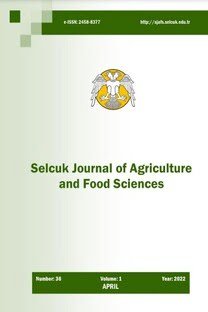Kuluçkanın son 4 günlük evresinde uygulanan farklı sıcaklık derecelerinin bazı organ ağırlıkları ile broyler performansına etkileri
Bu çalışmada, kuluçkalık broyler yumurtalarına,kuluçka işleminin son 4 günlük döneminde uygulanan 4 farklı sıcaklık derecesinin, çıkışta bazı organ ağırlıkları ile çıkış sonrası 3 haftalık büyütme periyodu sonunda gelişme ile ilgili performans değerleri, ve parmak külü'nde Ca ve P seviyeleri üzerine etkileri incelenmiştir. Bu amaçla, kabin sıcaklıkları 97, 99, 101 ve 103 °F olacak şekilde düzenlenmiş ve gruplar sırasıyla, D, KON, Y ve ÇY olarak kodlan-mıştır. Elde edilen sonuçlara göre; çıkışta kalp ağırlığı D muamele grubunda diğerlerine nazaran önemli (P
Anahtar Kelimeler:
etlik piliç, sıcaklık, performans, kuluçka
The effects of different temperature degrees in last four days of incubation on some organ weights and post hatch performance in broiler
In current study, the effects of four different cabinet temperatures for last four days of incubation in broiler hatching eggs on post hatch performance for 3 weeks of age and Ca and P mineral levels in toe ash were evaluated. In this respect, the cabinet temperatures were kept as 97, 99, 101 and 103 °F and termed as D, KON, Y, and ÇY, respectively, for last four days of incubation. The current results shows that the heart weight increased significantly (P<0.01) in D treatment group than did others at hatch.Moreover, the gizzard weights were lower (P<0.01) in Y and ÇY groups than did others at hatch too. On the contrary, the hearth, liver, gizzard weights were not different. The total mortality rates in D, Y and ÇY groups have exhibited higher values (P<0.05) than KON group. The toe ash Ca levels increased significantly (P<0.01) in Y group than did others, while treatment effects on P levels were not sig-nificant. There were found no differences among groups for post hatch performance traits.
Keywords:
broilers, temperature, performance, incubation,
___
- Albert,J.B., 1985. Calcium metabolism by the avian embryo. Phd Thesis. University of Louisville, ABD.
- Barrott, H.G., 1937. Effect of Temperature, humidity and other factors on hatch of hens’ eggs and on energy metabolism of chick embryos. USDA, Technical Bulletin, No.553, p. 1-45.
- Decuypere, E., 1994. Incubation temperature and postnatal development. sf: 407-410. In: Proceed- ings of 9th European Poultry Conference. Vol. II. World’s Poultry Sci., Assoc. Glasgow, UK.
- French, N.A., 1997. Modeling incubation temperature: The effects of incubator design, embryonic development, and egg size. Poultry Sci., 76:124- 133.
- Hulet, R.M., Gladys, G., Hill, D., Meijerhof, R., (2000). Embryonic temperature effects on post hatch performance in broilers. Poult. Avian Biol Rev., 11:298-299.
- Gladys, G.E., Hill,D., Meijerhof,R., Saleh,T.M., Hulet, R.M., 2000. Effect of embryo temperature and age of breeder flock on broiler post-hatch per- formance. Poult. Sci., 79 (supp.): S179.
- Meijerhof, R., 1999. Embryo temperature is the key factor in incubation. World Poultry- Elsevier. 15: 42-43.
- Künn, E.R., Vanderpoorten, a., Huybrechts, L.M., Decuypere,E., Darras, V., Sharp, P.J., 1988. H y- pothalamic hormones that release growth hor- mone stimulate the hepatic 5’monodeiodination activity in the chick embryo. J. of Endocrinology, 118: 233-236.
- MINITAB (1998). Minitab for Windows. Minitab inc., USA
- MSTAT (1989) Mstat-C: A Microcomputer Program for the Design, Management, and Analysis of Agronomic Research Experiments. Michigan State University – ABD
- North, M.O., Bell, D.D., 1990. Commercial Chicken Production Manual. An AVI Book. Van Nostrand Reinhold, 115, Fifth Avenue, NY.
- Richards, M.P., Packard, M., 1996. Mineral Metabo- lism in Avian Embryos. Poultry and Avian Biol- ogy Reviews. 7(2/3): 143-161.
- Romanoff, A.L., 1960. The Avian Embryo. New York: Macmillan.
- Rosen, V.A., 1981. Hormonal effects on calcification and bone development in the chick embryo. DAI- B 42/03, sf: 931, Sep. 1981.
- Sun-Kyeong, L., 1991. Role of the yolk sac in Ca regulation by developing embryos. Phd The- sis.The University of Connecticut.
- Wilson, H.R., 1991. Physiological requirements of the developing embryo: temperature and turning. Avian Incubation. Tullet,S.G., (ed.), pp 145-156. Butterworth- Heinemann Ltd.
- Wineland, M.J., 1996. Factors influencing embryo respiration. Poultry Digest, September; pp: 16-20
- Wineland, M.J., Mann, K.M., Fairchild, B.D., Fair- child, B.D., Chistensen, V.L., 2000. Effects of different setter and hatcher temperature upon the broiler embryo . Poult Sci., 79 (Supp.) : S123.
- Zhang, Q., Whittow, G.C., 1992. The effect of incu- bation temperature on oxygen consumption and organ growth in domestic fowl embryos. J. Therm. Biol. 17 (6): 339-345.
- Yi, Z., Kornegay, E.T. and Denbow, D.M. 1996. Supplemental Microbial Phytase Improves Zinc Utilization in Broilers. Poultry Sci. 75: 540-546.
- ISSN: 1300-5774
- Yayın Aralığı: Yılda 3 Sayı
- Başlangıç: 2018
- Yayıncı: Selçuk Üniv. Ziraat Fak.
Sayıdaki Diğer Makaleler
Buğday bitkisinin besin elementi kapsamı ile toprak özellikleri arasındaki regresyon ilişkiler
İskender YILDIRIM, Ramazan YETİŞTİR
A study on the soil tare of sugar beet in Konya
MEHMET ZENGİN, Refik UYANÖZ, Ümmühan ÇETİN
Vegetatif olarak üretilen bitkilerde mutasyon ıslahı
Çanakkale İlinin turizm potansiyeli ve çeşitlendirilmesi
Konya Ovasında su kaynakları kullanımı
NİZAMETTİN ÇİFTÇİ, İlknur KUTLAR, MEHMET ŞAHİN, A. Melih YILMAZ
BİROL DAĞ, İSMAİL KESKİN, UĞUR ZÜLKADİR, SAİM BOZTEPE
Bazı kil tiplerinin bor adsorpsiyon kapasitelerinin belirlenmesi
MEHMET HAMURCU, H. Hüseyin ÖZAYTEKİN, Fariz D. MIKAİLSOY, Sait GEZGİN
